Photos with this report (click to enlarge) | |||
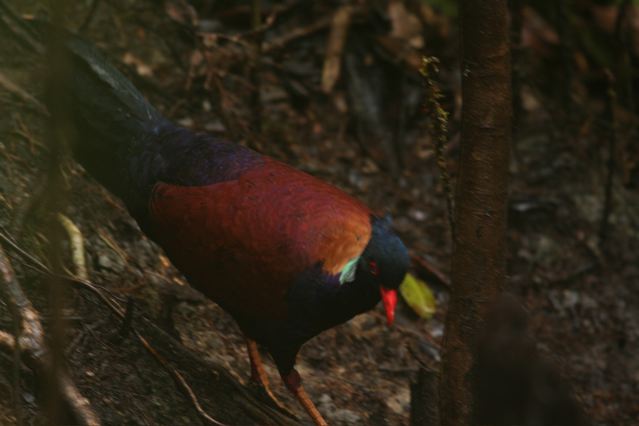 Pheasant Pigeon |
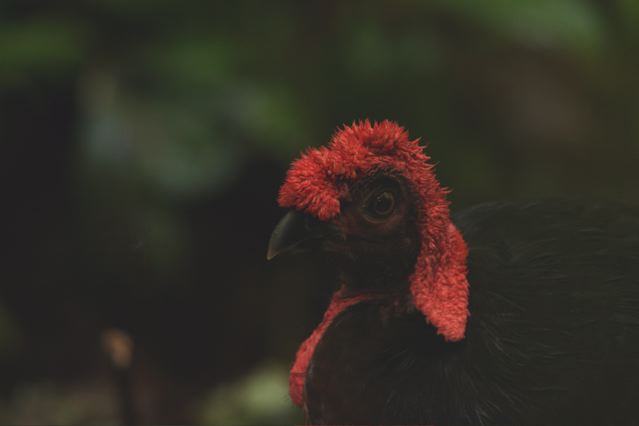 Bruijn's Brush-Turkey |
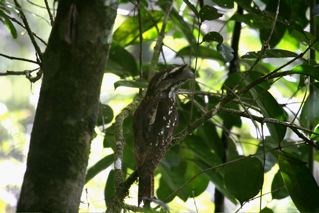 Marbled Frogmouth |
|
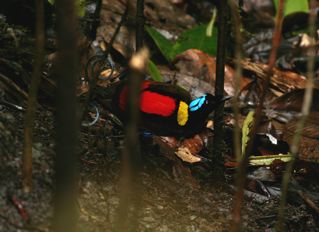 Wilson's Bird-of-Paradise |
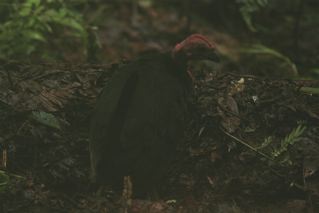 Bruijn's Brush-Turkey (female) |
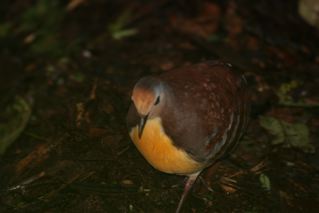 Cinnamon Ground-Dove |
|
Waigeo is a large island in the Raja Ampat group off the west coast of West Papua. It is accessible by an expensive five-hour boat trip from Sorong, a bit further than Batanta and Salawati. Waigeo has large areas of pristine forest, an endemic bird (Bruijn’s Brush-Turkey) and large mammal (Waigeo Cuscus), as well as large populations of other specialties like Red and Wilson’s Bird-of-Paradise, Brown-necked Crow, Western Crowned-Pigeon and Pheasant Pigeon.
I made a three-week trip to Mount Danai together with Iwein Mauro, a Belgian birdwatcher, and Zeth Wonggor, a guide from the Arfak Mountains. Before the trip, Iwein was the only birdwatcher to have seen Bruijn’s Brush-Turkey in the field. In fact, the inhabitants of Waigeo (at least the part we visited) do not seem to be familiar with this species, which mostly inhabits the hills in the interior of the island, whereas the human population seems to be restricted to the coast and, based on our experiences, rarely ventures more than a few kilometres inland.
Mount Danai is not the highest hill on Waigeo nor the most accessible. Rather, it is the area with the greatest extent of land above 650m, and would be expected to hold the largest population of Bruijn’s Brush-Turkey. The slopes of Mount Salal, the highest mountain on the island further to the north, were extensively burned a few years ago, and lower elevations are covered by impenetrable scrub. Mount Nok, while close to the coast, is a limestone hill surrounded by cliffs. It is quite a job to climb, and its summit holds only a few pairs of brush-turkeys. While we had some trouble finding Mount Danai, in the end we did get to its upper slopes, and the whole of our route passed through pristine forest. Please contact me for a sketch map of the area.
Getting there: Waigeo is a five-hour boat ride from Sorong, costing about 2 million Rupiah each way (subject to negotiation). Unless the boat stays on the island the whole time you are there, you will need to arrange a pick-up date, and hope that the boat indeed turns up!
Sorong is the second largest town on West Papua. I flew Silk Air round-trip from Singapore to Manado (on northern Sulawesi), then took a direct flight from Manado to Sorong on a large but elderly Merpati airline. The Merpati flight is direct only in this direction – I made the Sorong-Manado return leg on Wings Air (“Life is Cheap”). Sorong has a supermarket, a few banks and several hotels.
Facilities on Waigeo: None. You will need to ship in all your food and equipment from Sorong. At present, there are no roads into the interior of the island – all the settlements are coastal fishing villages. Once on the island, I don’t think you could even count on a local offering to put you up, or being able to rent a boat for the return leg, so it is important to make good arrangements in Sorong.
Weather: We made the visit during the rainy season for a chance to see a male brush-turkey in breeding plumage. It rained heavily almost every day. A tarpaulin is better than a tent. Zeth was very adept at making wooden beds and tables at our campsites to keep us off the ground. After arriving late at our 450m campsite in the rain, we had the bright idea of putting a tarpaulin on the ground to keep everything dry. The unintended consequence was that all the water ran down to the lowest point, which was our rice sack. From that point on, we had to cut down to two meals a day, and it was lucky all the porters had left several days before that, so we didn’t have the extra mouths to feed! Our other mistake was carrying all the food in cardboard boxes, which broke open in the rain on the very first day. I’d recommend those waterproof rucksacks that are a bit like diving bags with arm straps.
If you hike up a river and/or the conditions are wet, it is best to use Wellingtons rather than hiking boots, which will not dry out.
Permission and porters: On arrival at Waigeo, we stopped at the village of Sion (see map) to obtain permission and hire some porters. We requested four porters but were provided with a rag-tag band of seven, mostly teenagers. They didn’t know the way up Mount Danai and clearly didn’t feel comfortable in the forest, claiming to have had encounters with “Orang Gee” (forest people – whether they are ghosts or flesh-and-blood depends on who you ask – could this be the modern-day home of Homo florensis?!) One of our porters left after the first day, a few more after the second day, and the remaining three all left on the third day, after we had set up the 120m campsite and scouted to 450m. This meant a ton of extra work for Zeth – our only remaining machete-owner, and the only one of us competent to cut trails at a reasonable speed, set up camps, construct hides (by the bird-of-paradise leks and brush-turkey mound), and make fires in the sodden conditions. We had to take a lot of extra days while Zeth cut trails, and had to make two trips to carry all our equipment and food between campsites.
Hazards: The people in Sion said that the Orobiai river canyon is prone to flash floods. Much of the terrain is rugged karst (limestone) – it is best to avoid karst areas if you can, since they have steep slopes, cliffs, and sinkholes, and normally lack drinking water (since limestone is soluble and the streams tend to run underground). We encountered several large trees that had come down recently in the wet and windy weather during our trip.
Of the animals, one to watch out for is the New Guinea Small-eyed Snake, sometimes called the “white snake”, although both pale and dark morphs occur on Waigeo. It has a very strange, wormlike head with tiny eyes, is common in the forest and its bite can be fatal. It responds aggressively to light, so be careful with your torches at night.
Monitor lizards are common on the island, so make sure to hang everything up safely if you leave your camp unattended.
Photos: I have reduced the quality of these photos for the Surfbirds Web site. Please contact me at daviesc1973@hotmail.com if you would like higher quality versions. I have other photos of both male and female Bruijn’s Brush-turkey, including some poor photos of the male displaying, and photos (mostly record shots) of some of the other birds we saw.
Jepman island: This small island, off the coast of Salawati, used to host the airport for Sorong, and the dilapidated runway takes up much of the interior of the island. It is an hour’s boat ride from Sorong (with boat taxis from town), and only 4 hours from Waigeo. We stopped in Jepman for a night on the way to Waigeo, and spent a few hours birdwatching – Peregrine Falcon and Blue Rock-Thrush were our most interesting sightings.
Birds on Jepman island: Lesser Frigatebird (3), Osprey (1), Peregrine Falcon (1), Pacific Golden-plover (30), Lesser Sand-plover (25), Red-necked Stint (5), Common Sandpiper (1), Pacific Swallow (10), Blue Rock-thrush (ssp philippensis, 1, perched on the airport hanger), Willie-wagtail (1), Varied Honeyeater (5), White-breasted Woodswallow (5), Singing Starling (10)
Crossing to Waigeo: Seawatching was pretty good on this four-hour trip (each way). The highlight was a pod of about 200 dolphins as we approached coast of Waigeo, which performed for us with the island’s mountains as a backdrop.
Birds on boat trips to and from Waigeo: Lesser Frigatebird (1), Brown Booby (5), Red-necked Phalarope (15), Great Crested Tern (5), Bridled Tern (about 70), Pomarine Skua (1), Black Noddy (50+ mostly in one group on the return trip)
Waigeo coast and Orobiai river: Waigeo island is almost split into eastern and western halves, which are connected by a narrow isthmus on the northern side of the island. A narrow sea channel (with treacherous currents, according to our boatman) leads to a central lagoon, which we did not visit. We arranged our porters at the village of Sion, on the western side of the entrance channel. The mouth of the Orobiai river is on the opposite (eastern) side of the channel, a short way to the north of the village.
The first few kilometres of the river pass through a shady canyon between two ranges of limestone hills. You can walk quite fast along the wide gravel banks, but some deep sections of the river have to be waded across. On the return trip, we saw a Western Crowned-Pigeon walking around on the gravel.
After passing through the canyon, the river forks. There is a small garden with papayas and cassava on the south bank of the stream, and we camped at this spot in each direction. From here, one branch of the river travels north, skirting the eastern edge of a range of limestone hills, and another branch travels east-north-east. On the way up, we hiked several kilometres up the eastern branch and made a camp on a ridgetop above the river at about 120m altitude. On the way back, Zeth and Iwein scouted a more direct route down to the northern branch of the Orobiai (see map).
Above the fork, the river becomes rocky and more difficult to navigate, with rapids and some small waterfalls.
The forest around the 120m campsite looked undisturbed but was quite strange, with numerous small trees growing densely together. Maybe there had been a fire in this area 20 or 30 years ago? Western Crowned-Pigeon (seen at the start of our second food run up to 450m) was again the highlight in this area – we didn’t see many birds overall.
Itinerary:
• 17 March – Boat to Waigeo, met village chief and hired porters in Sion, hiked up Orobiai canyon in rainstorm, camped at fork in river.
• 18 March – Hiked about 4km up eastern branch of river and set up camp at 120m.
• 19 March – Scouting to another campsite further up the ridge at 450m.
• 20 March – Porters left in the morning. Iwein, Zeth and I carried half our gear up to 450m and established a new campsite (in the rain again).
• 21 March – Returned to 120m to collect remaining half of our food and equipment.
• 8 April – Hiked from 450m campsite back down to the camp at the fork in the rivers, via the northern branch of the river.
• 9 April – Morning hike back down to the coast, met our boat and travelled back to Sorong.
(Total of about a day’s birdwatching along the river, and a day at 120m)
Along the Orobiai river up to the riverside camp at 120m: Little Egret, Radjah Shelduck, White-bellied Sea-eagle, Common Sandpiper, Great Cuckoo-dove, Slender-billed Cuckoo-dove, Western Crowned-Pigeon (2), Pinon Imperial-Pigeon, Palm Cockatoo, Sulphur-crested Cockatoo, Rainbow Lorikeet, Black-capped Lory, Eclectus Parrot, Glossy Swiftlet, Uniform Swiftlet, Yellow-billed Kingfisher (heard), Dollarbird, Blyth’s Hornbill, Azure Kingfisher, Willie-wagtail, Helmeted Friarbird, Spangled Drongo, Red Bird-of-paradise (heard), Hooded Butcherbird, Black Butcherbird (heard), Brown-necked Crow (common)
450m campsite: This was a few kilometres almost due north of the 120m campsite. For the most part, the ridgetop ascended gradually, with a couple of very steep ascents, and other flat sections of strange, boggy forest with lots of pitcher plants. Above about 400m, the forest became much taller with higher bird densities.
• 19 March – Scouted from 120m to this campsite
• 20 March – Carried up half of food and supplies.
• 21 March – Returned to 120m campsite and carried up remainder of food and supplies.
• 22 March – Birdwatching around 450m campsite.
• 23-24 March – Scouting from 450m to new campsite at 570m altitude.
• 25 March – Carried half of supplies and established camp at 570m
• 28 March – Returned from 570m campsite to collect the remainder of the food and equipment
• 6 April – Returned from Mount Danai to 450m campsite (first rain-free day of the trip!)
• 7 April – Birdwatching around 450m campsite
• 8 April – Hike back down to Orobiai river
(Total of about 3 days birdwatching around the 450m campsite)
Birds and mammals around 450m campsite: – Brahminy Kite, Long-tailed Honey-Buzzard, Variable Goshawk, Great Cuckoo-Dove, Slender-billed Cuckoo-Dove, Western Crowned-Pigeon (heard), Pheasant Pigeon (heard), Beautiful Fruit-Dove, Wompoo Fruit-Dove (heard), Purple-tailed and Pinon Imperial-Pigeons, Sulphur-crested Cockatoo, Rainbow Lorikeet, Black-capped Lory, Eclectus Parrot, Moluccan King-Parrot, White-crowned Koel (heard), Dwarf Koel (heard), Greater Sooty-Owl (heard), Jungle Hawk-Owl (heard), Rufous Owl (heard), Marbled Frogmouth (heard), Glossy Swiftlet, Hook-billed Kingfisher, Rufous-bellied Kookaburra (heard), Yellow-billed Kingfisher (heard), Common Paradise-Kingfisher (about 350m on the way back down), Blyth’s Hornbill, Northern Fantail, Frilled Monarch, Golden Monarch, Yellow-breasted Boatbill, Olive Flyrobin, Black-sided Robin, Gray-headed Whistler, Rufous Shrike-thrush, Rusty Pitohui, Variable Pitohui, Rusty Mouse-warbler, Pale-billed Scrubwren, Fairy Gerygone, Yellow-bellied Longbill (one nesting), Mimic Honeyeater, Tawny-breasted Honeyeater, Helmeted Friarbird, Brown Oriole (heard), Spangled Drongo, Hooded Butcherbird, Wilson’s Bird-of-paradise (4), Red Bird-of-paradise (about 25 displaying males, and only 2 females), Brown-necked Crow, Yellow-faced Myna, Waigeo Cuscus (3)
570m campsite – This campsite was only a few kilometres east-north-east from the 450m campsite, but getting there was tortuous because it involved traversing an area of karst, followed by a point where the ridgetop dropped sharply about 50m in between the source of two rivers running off in opposite directions. Scouting to this campsite took two-and-a-half days, mostly in heavy rain, for only a slight gain in altitude. Getting from the 570m campsite to the highest campsite we made on the slopes of Mount Danai (750m), also took several days, with one whole day lost to heavy rain.
The forest at the 570m campsite was again tightly packed with smaller trees, and the bird composition was quite different – and less rich – than that at our 450m campsite. One of the Waigeo upper-elevation birds – Beccari’s Scrubwren – came in at 570m.
Itinerary:
• 25 March: carried half of the supplies to 570m campsite, and set up the camp in some cold rain.
• 26 March: Lost the whole day to heavy rain.
• 27 March: I birdwatched around the campsite; Zeth and Iwein scouted uphill to 800m, finding some brush-turkey mounds that had been raided by pigs.
• 28 March: Collected remainder of food and equipment from 450m campsite.
• 29 March: Improved trail uphill.
• 30 March: Hiked up to highest campsite, at about 750m, on the slopes of Mount Danai.
(Total of about 1.5 days birdwatching)
Birds around 570m campsite: – Slender-billed Cuckoo-dove (heard), Pheasant Pigeon (heard), Western Crowned-Pigeon (heard), Wompoo Fruit-Dove, Purple-tailed Imperial Pigeon, Pinon Imperial-Pigeon (heard), Palm Cockatoo, Sulphur-crested Cockatoo, Moluccan King-Parrot (lots), Jungle Hawk-Owl (heard), Marbled Frogmouth, Rufous-bellied Kookaburra, Hook-billed Kingfisher (heard), Yellow-billed Kingfisher (heard), Blyth’s Hornbill, Sooty Thicket-Fantail (heard), Northern Fantail, Frilled Monarch, Yellow-breasted Boatbill, Black-sided Robin, Gray-headed Whistler, Rufous Shrike-Thrush, Rusty Pitohui, Variable Pitohui, Rusty Mouse-Warbler, Fairy Gerygone, Beccari’s Scrubwren, Pale-billed Scrubwren, Puff-backed Honeyeater (common), Spotted Honeyeater (common), Helmeted Friarbird (heard), Brown Oriole (heard), Spangled Drongo, Hooded Butcherbird (heard), Wilson’s Bird-of-paradise (3 females – males heard only), Red Bird-of-paradise (2 males), Glossy-mantled Manucode (2), Brown-headed Crow (heard), Yellow-faced Myna, Olive-crowned Flowerpecker (none had any red), Long-billed Honeyeater
750m campsite – This was a few kilometres further north-east from the 570m campsite. The 570m campsite turned out to be on an isolated ridge, and we had to descend steeply about 100m to a small stream, walk upstream for about a kilometre, then climb very steeply to another ridgetop at about 700m. Descending just a short way the other side of this ridgetop, we came to a river that was, surprisingly, much larger than the small stream from which we had climbed up all that way. Perhaps an upper stretch of the Orobiai? From this river, we climbed steeply up to another ridgetop and made our final campsite at about 750m, again in heavy rain, in some very tall forest. The muddiest site of all, which is saying something.
From our campsite, the ridge ascended gradually to at least 860m, and perhaps continued all the way up to the summit of Mount Danai?
Itinerary:
• 30 March: Hiked up to 750m campsite.
• 31 March: Cut a trail further up the ridge, to 850m.
• 1-2 April: Scouting for mounds and monitoring areas of brush-turkey activity. Active mound found on the 2nd at 860m, just a hundred metres from where we stopped on the 31st.
• 3-5 April: Monitoring brush-turkey mounds and Wilson’s Bird-of-Paradise leks.
Birds and mammals around 750m campsite: Bruijn’s Brush-Turkey (2), Slender-billed Cuckoo-Dove (heard), Great Cuckoo-Dove (1), Cinnamon Ground-Dove (1 at brush-turkey mound), Pheasant Pigeon (4 seen, many heard), Wompoo Fruit-Dove (heard), Superb Fruit-Dove, Purple-tailed Imperial-Pigeon (heard), Pinon Imperial-Pigeon (heard), Sulphur-crested Cockatoo (heard), Black-capped Lory (nesting), Moluccan King-Parrot, Jungle Hawk-Owl (heard), Marbled Frogmouth (roosting), Wallace’s Owlet-Nightjar (1 seen and 2 heard), Yellow-billed Kingfisher, Rufous-bellied Kookaburra (heard), Hook-billed Kingfisher (heard), Blyth’s Hornbill, Red-bellied Pitta (on brush-turkey mound), Sooty Thicket-Fantail (heard), Yellow-breasted Boatbill, Olive Flyrobin, Rufous Shrike-Thrush, Variable Pitohui, Rusty Mouse-Warbler (heard), Pale-billed Scrubwren, Beccari’s Scrubwren, Black Berrypecker (about 720m on the way out), Yellow-bellied Longbill, Olive-crowned Flowerpecker, Long-billed Honeyeater, Black Myzomela, Mountain Meliphaga, Helmeted Friarbird (heard), Spangled Drongo, Hooded Butcherbird (heard), Black Butcherbird (heard), Wilson’s Bird-of-paradise (3 males and 1 female seen), Red Bird-of-paradise (1 male seen), Brown-headed Crow (heard), bandicoot and possum spp. (seen at night)
Notes on some interesting species:
Bruijn’s Brush-Turkey. After taking much longer than expected to get to the right elevation, we were eventually successful in finding a breeding male brush-turkey, which surprised us with spectacular, inflated wattles forming a red “hood” and contrasting with brown facial skin.
We found evidence of this species only around the 750m campsite. Most of the mounds had been predated by wild pigs – Zeth had experienced this problem with Wattled Brush-Turkey in the Arfaks. In 3 days searching, Zeth found 1 active mound, 3 mounds, 1 abandoned mound, and 5 areas where it looked like brush-turkeys had started to build new mounds. Brush-turkeys have managed to coexist with pigs for several thousand years, but the pigs did seem to be having a serious effect here.
We had three mornings to monitor the active brush-turkey mound once we located it. On the first day (3 April), the male arrived about 6:20am and left at about 9:40am and displayed on its mound.
The mound was built a bit like a mini-volcano, with a raised perimeter and a crater in the centre. The brush-turkey’s routine involved running or walking around the edge of the mound (about 75%), and scratching out various small holes (perhaps places where females could deposit eggs?), then filling the holes up and making new holes (about 25%). Once, the male lay down and spread its wings wide over one of these holes. About 10-15 times the male displayed, standing on the edge of the mound, craning its neck up, beating its wings heavily (normally 9 times), then opening its mouth and giving a sigh – aah! I wonder if the sigh has replaced louder vocalizations that would attract pigs? Towards the end of its appearance, the male ran up the slope a few times and performed the display routine away from the mound.
On 4 April, the male showed up very briefly (6:40-6:50am) but it didn’t display. Perhaps it had been spooked by my flash photos the day before. Then a female came for a bit longer, from 7:40 to 8:30am. It dug an incubation hole in one side of the interior of the mound, then closed it up and dug another hole. On 5 April, the male brush-turkey didn’t show up at all, and the female was heard briefly and glimpsed around 8am.
Western Crowned-Pigeon – Only two seen (one on lower stretch of Orobiai river and one at 120m campsite), but regularly heard up to about 700m. They make a soft, deep booming call and flush with a distinctive double-clapping noise.
Pheasant Pigeon – Heard down to about 400m altitude, but quite common at higher elevations. Frequently seen on a Wilson’s BOP lek at about 800m.
Greater Sooty-Owl – One bird heard during several nights in the tall forest around the 450m campsite. As far as I know, this is the first record of this species on Waigeo.
Rufous Owl – The subspecies on Waigeo is small and rarely seen. We heard a pair near the 450m campsite on our final night there.
Marbled Frogmouth – Present at all of the three upper-elevation campsites, and seen at two of them, this species must be common on the island.
Wallace’s Owlet-Nightjar – Iwein discovered and recorded this species during a previous visit to Mount Salal. It seems to be restricted to the hill forest on Waigeo.
Beccari’s Scrubwren – One of the commonest birds at higher elevations. Iwein discovered this on Waigeo during a previous visit to Mount Salal.
Brown-necked Crow – The common crow in the interior of Waigeo, seen and heard at all elevations, and especially common at lower and mid-elevations.
Red Bird-of-Paradise – Recorded at all elevations, especially common at the 450m campsite. About 30 males and only 2 females in total. The males were starting to come into breeding plumage (but still lacked the yellow flank plumes), and were gathering in leks near the 450m campsite. But the females didn’t seem to be visiting the leks yet – both of ours were seen in mixed flocks with Rusty Pitohui.
Wilson’s Bird-of-Paradise – The lowest individual heard about 150m, more common at mid and high-elevations, with one lek found above 800m altitude. A total of 4 males and 6 females seen during the trip. The males had cleared their leks but no females were visiting, so the males tended to call from the trees above the leks and didn’t spend much time on the ground.
Waigeo Cuscus – Three individuals seen during the daytime within a kilometre of the 450m campsite, including one in the karst area.